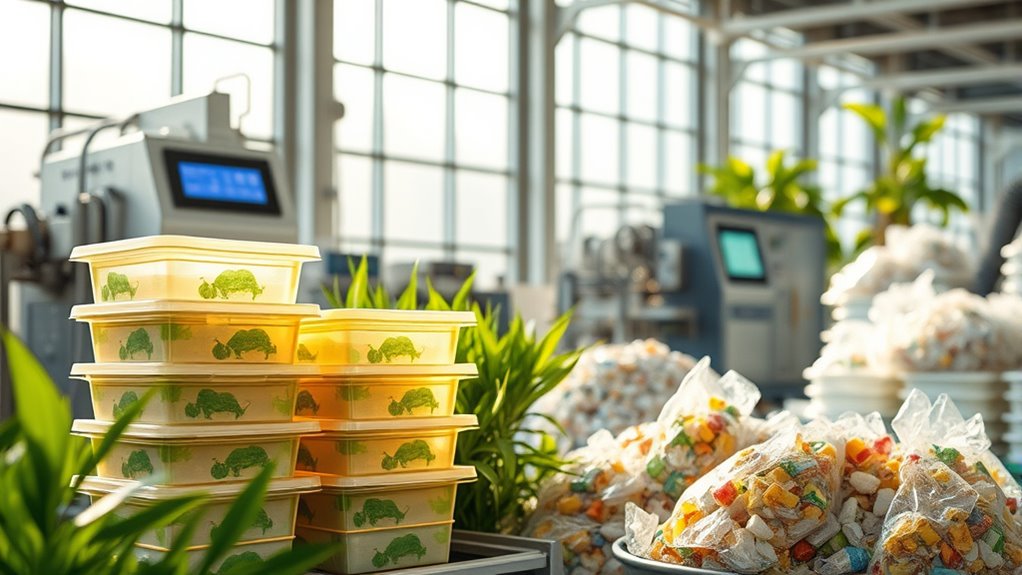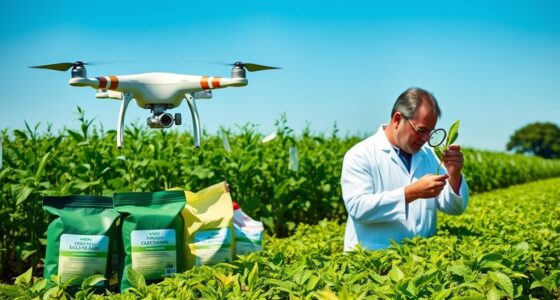The future of plastics focuses on advanced recycling methods and increasing bioplastics use to promote a circular economy. Cutting-edge technologies like AI-powered sorting and chemical recycling improve efficiency and handle contaminated waste. Market growth is driven by policies, consumer demand, and industry collaborations, supporting sustainable materials. Scaling infrastructure and developing recycling-friendly innovations will shape eco-friendly plastics, reducing reliance on fossil fuels. Continued progress indicates promising solutions—explore further to understand how these trends will transform the industry.
Key Takeaways
- Advances in AI-powered sorting and chemical recycling technologies will significantly improve plastic waste processing efficiency and purity.
- Growing adoption of bioplastics from renewable sources and waste biomass will enhance sustainability and biodegradability.
- Strong industry collaborations and supportive policies, like EPR and recycled content mandates, will boost recycling infrastructure and market demand.
- Consumer preferences for eco-friendly, durable, and recyclable products will accelerate the shift towards a circular plastics economy.
- Innovations in recycling-friendly adhesives and sorting methods will enable better integration of diverse plastics and bioplastics into existing systems.
Advancements in Mechanical and Chemical Recycling Technologies
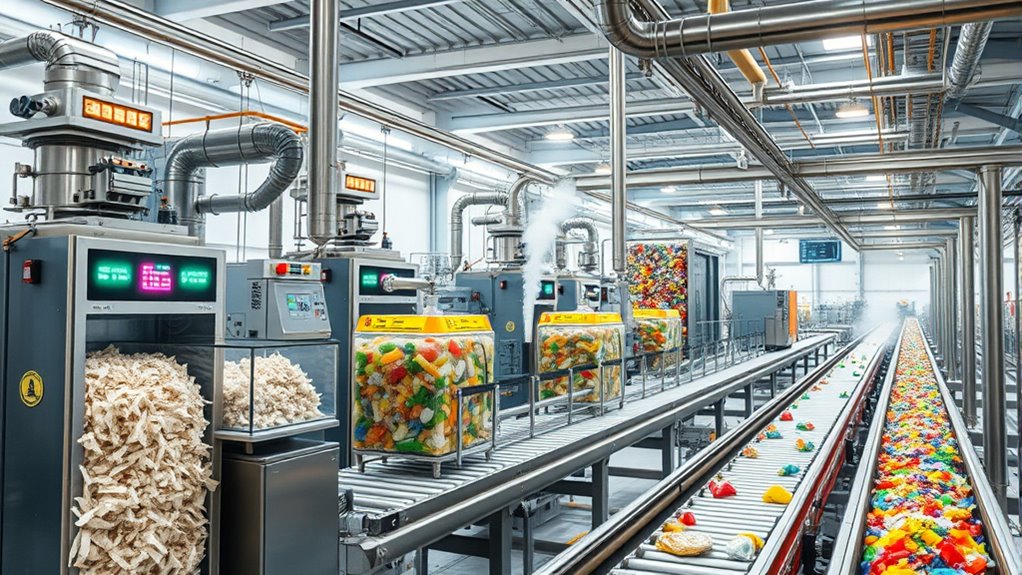
Recent advances in recycling technologies have considerably improved the efficiency and quality of plastic reuse. You’ll notice AI-assisted sorting systems now categorize waste by polymer type, color, and properties, increasing purity and speeding up processes. Automated identification reduces human error and integrates seamlessly with smart infrastructure, optimizing material flow in facilities. Advanced Mechanical Recycling (AMR) techniques further enhance this process by incorporating presorting with AI-assisted systems, shredding for uniformity, and hot washing to remove contaminants. When it comes to depolymerization, innovations like Denovia’s rapid five-minute process revert plastics to virgin-quality monomers, even handling contaminated or soiled plastics without pretreatment. Chemical recycling has expanded with thermal conversion and catalytic cracking methods, boosting yield of valuable hydrocarbons. Additionally, solvent-based purification separates polymers from complex multilayer packaging. These breakthroughs empower you to process plastics more efficiently, produce higher-quality recycled materials, and push the industry toward a more sustainable, circular economy. Recycling efficiency has been notably improved through these technological innovations, making sustainable practices more feasible for manufacturers and consumers alike.
Global Growth Projections for the Recycling Market
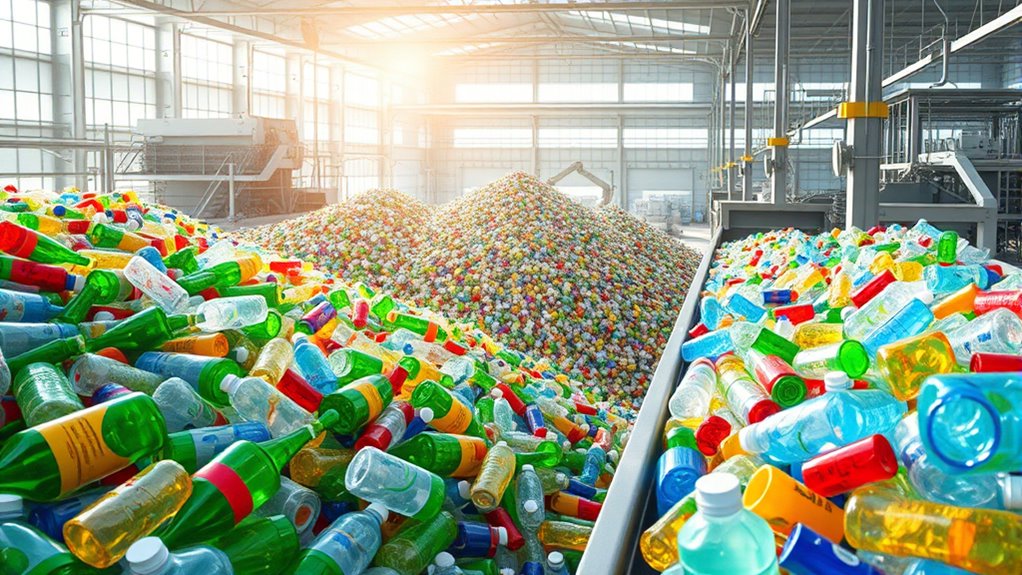
The global recycled plastics market is poised for significant growth over the next decade, driven by rising demand across multiple industries.
In 2023, the market was valued between USD 51.10 billion and USD 69.4 billion, with projections reaching USD 107.13 billion to USD 120 billion by 2030.
The compound annual growth rate ranges from 6.4% to 9.5%, fueled by increased plastic consumption and demand for lightweight components in construction, electronics, automotive, and packaging.
The Asia-Pacific region dominates market size and growth, benefiting from diverse industrial needs.
Growing investments in recycling infrastructure, stricter regulations, and the push for sustainability also support expansion.
Despite challenges like supply chain issues and technological limitations, market opportunities continue to thrive as demand for eco-friendly materials rises globally.
Additionally, advancements in recycling technology are expected to improve material recovery rates and cost efficiency, further boosting market growth.
Innovations in Sorting: AI and Sensor-Based Systems
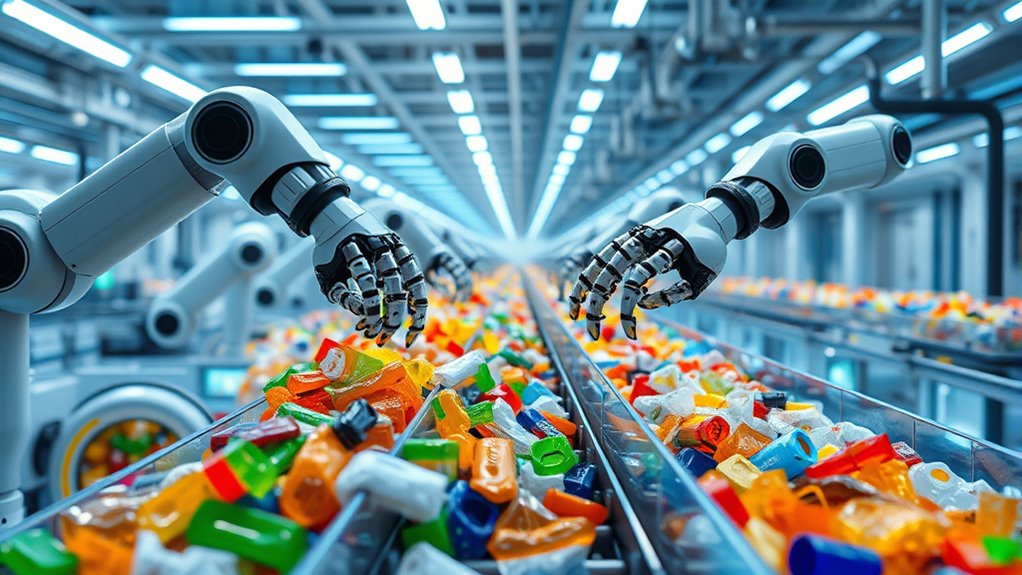
Innovations in sorting technologies are revolutionizing the recycling industry by leveraging AI and advanced sensors to achieve unprecedented accuracy and efficiency. AI-enhanced systems like TOMRA’s GAINnext™ use deep learning to separate plastics with higher precision, even materials that were previously inseparable. GAINnext leverages deep learning to enhance sorting accuracy. AUTOSORT™ combined with AI classifies plastics swiftly at industrial speeds, while AMP Robotics’ platform sorts by color, size, shape, and brand, increasing granularity. AI-guided robotic sorters can process over 80 items per minute, doubling human speed, with greater consistency. Sensor integration, such as near-infrared spectroscopy and high-resolution cameras, detects polymer types, colors, and contaminants down to 1 mm. These innovations substantially boost throughput, reduce manual labor, and improve recycling purity, making the process faster, cleaner, and more cost-effective. Additionally, ongoing advancements in recycling technology are enabling more comprehensive sorting capabilities, further optimizing resource recovery and sustainability.
Policy Initiatives and Economic Incentives Supporting Recycling
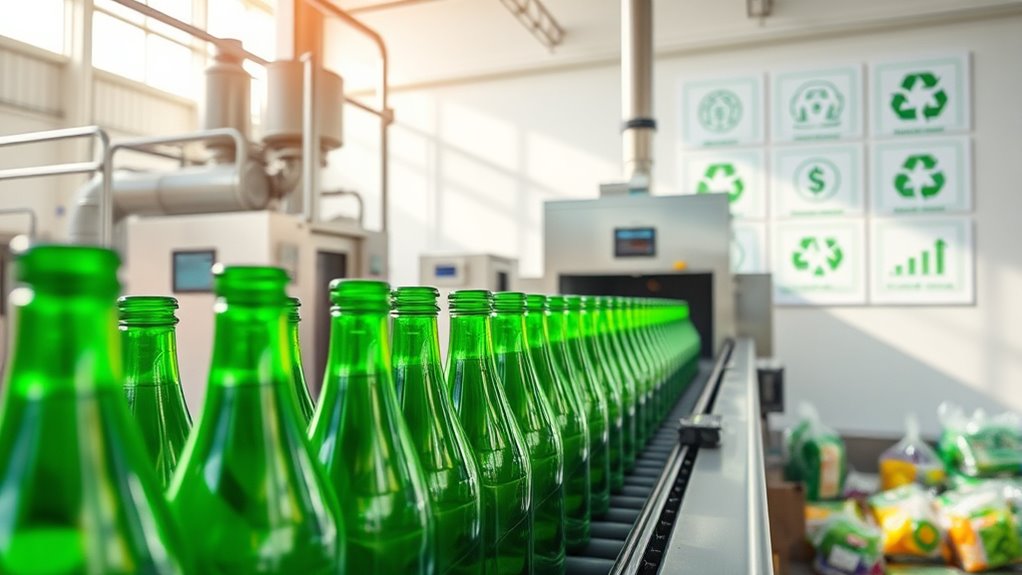
Policy initiatives and economic incentives play a pivotal role in advancing recycling efforts by encouraging sustainable practices and supporting the development of recycling infrastructure. Extended Producer Responsibility (EPR) policies fund and coordinate recycling programs, boosting collection rates and reducing waste. Speaks 4 Me Online emphasizes that engaging expert voice actors can enhance the dissemination of these policies to broader audiences. Harmonized design standards simplify consumer choices and enhance processing efficiency, resulting in higher-quality recycled plastics. Minimum recycled content requirements mandate the use of recycled materials, creating market demand and supporting collection efforts. Economic tools like tax credits and investment incentives encourage businesses to prioritize recycled over virgin plastics, while bottle deposit programs incentivize recycling and reduce litter. These policies collectively foster a circular economy, promote reuse and recycling, and drive investments that make recycling more efficient, cost-effective, and environmentally beneficial.
Scaling Recycling Infrastructure and Capacity Targets
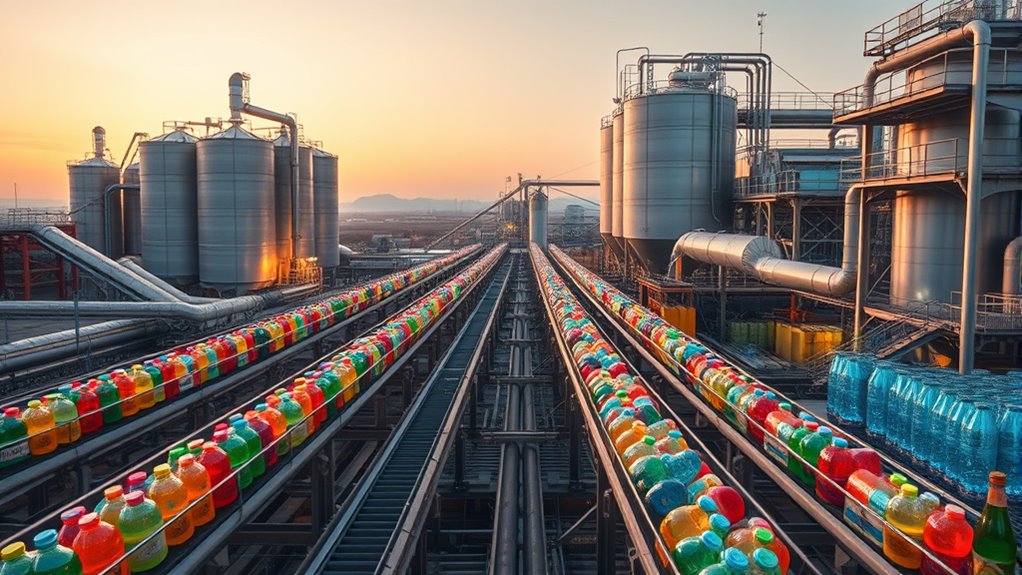
Scaling recycling infrastructure is essential to meet rising demand for recycled plastics and achieve sustainability targets. Currently, infrastructure gaps hinder progress, making it difficult to meet ambitious goals like using all recyclable plastic packaging by 2025.
Organizations like WRAP and Defra have analyzed capacity, highlighting the need for expansion, while tools such as the Recycling Infrastructure and Market Opportunities Map identify key improvement areas. Additionally, developing standardized headphone jacks can improve compatibility and ease of use across different devices, supporting broader adoption of portable electronics.
Meeting global recycling rates of 63% would require nearly a tenfold increase in capacity. Future expansion is expected, especially in Europe by 2030, but technological limitations, high investment costs, and policy support remain challenges.
Growing capacity will boost market development, create jobs, and reduce environmental impact, making scalable recycling infrastructure crucial for a sustainable plastics future.
Emerging Trends in Bioplastics and Sustainable Materials
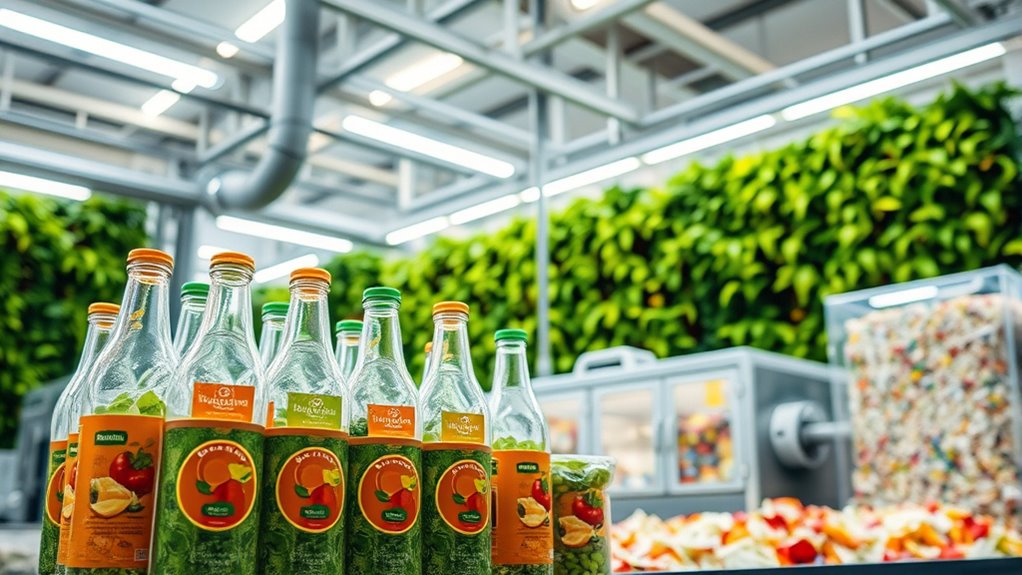
Emerging trends in bioplastics and sustainable materials are transforming how industries approach environmental impact. You’ll see a surge in innovative bioplastic materials like polylactic acid (PLA), polyhydroxyalkanoates (PHA), and starch blends from renewable sources such as corn, sugarcane, and agricultural waste.
These bio-based plastics offer a lower carbon footprint and are being enhanced for better biodegradability and performance. Additionally, algae- and lignin-based plastics are emerging as promising alternatives, expanding beyond traditional plant inputs.
The use of waste biomass, agricultural residues, and carbon dioxide for bioplastic production supports circular economy principles. Advancements in manufacturing—like energy-efficient processes and renewable energy integration—further boost sustainability.
These developments enable you to choose greener materials across sectors, from packaging to automotive, shaping a more sustainable future. Incorporating sound design techniques from trailer music can inspire innovative approaches to communicating the importance of these sustainable materials.
Challenges and Opportunities in Recycling Contaminated Plastics
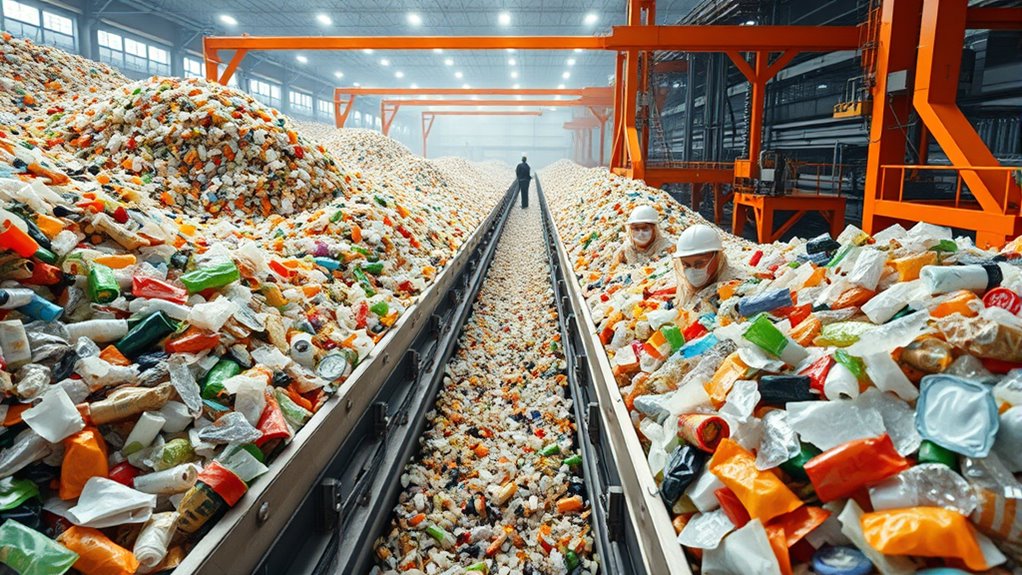
Recycling contaminated plastics presents significant challenges that hinder the efficiency and quality of recycling processes. Food residues, for example, make plastics less recyclable, often leading to landfilling.
Mixed plastic types like PET, PVC, and LDPE create incompatible streams, lowering output quality. Non-plastic contaminants such as labels and adhesives complicate sorting and raise costs.
Hazardous chemicals like PFAS and phthalates limit recyclability and pose health risks. Microplastic generation during mechanical recycling spreads pollutants into air and water.
Manual sorting often results in high contamination rates, and advanced technologies require costly investments that many facilities can’t afford. Inconsistent standards and small plastics that evade detection further reduce recycling efficiency.
Addressing these hurdles offers opportunities for innovation, improved sorting methods, and better regulatory frameworks to enhance contaminated plastic recycling. Additionally, Kia Tuning has explored advancements in materials that could lead to more recyclable plastics in the future.
The Role of Industry Collaboration and Strategic Partnerships
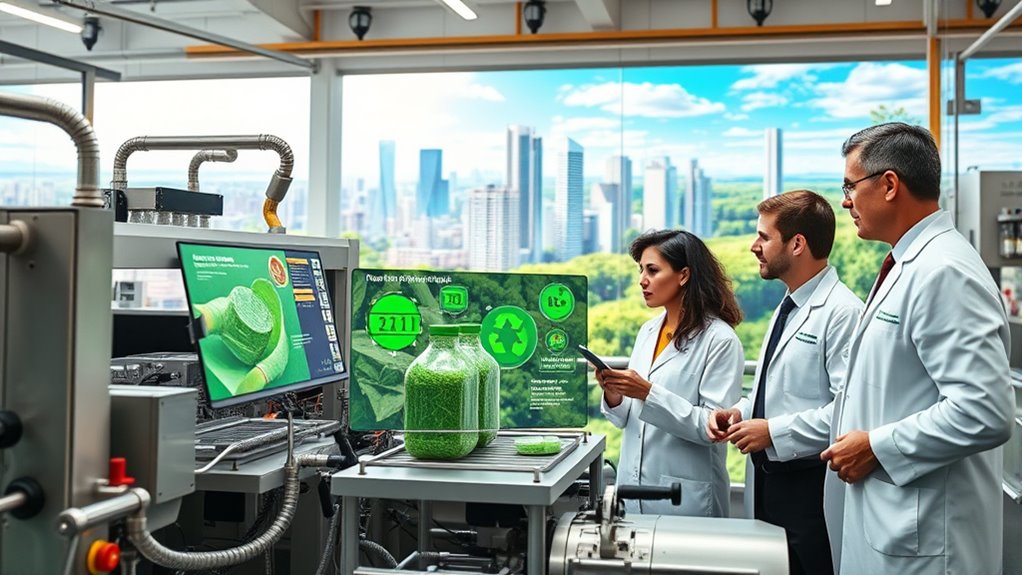
Overcoming the challenges of recycling contaminated plastics requires more than just technological innovation; it depends heavily on collaboration across industry sectors. Test centers foster experimentation and idea exchange among experts and customers, driving innovation.
Collaboration across industry sectors is essential for advancing contaminated plastics recycling and driving innovation.
Strategic partnerships, like those with Closed Loop Partners, help advance recycling technologies and infrastructure, making processes more efficient and cost-effective. Industry alliances, such as the Polystyrene Recycling Alliance, improve recycling efforts and infrastructure, while project-based collaborations develop targeted solutions like recycling-friendly adhesives.
These partnerships optimize resources, reduce costs, and enable equipment upgrades, including innovative extruders and better sorting technologies. They also support the development of bioplastics by encouraging sustainable production methods and expanding markets. Understanding recycling compatibility is crucial for improving recycling rates and reducing plastic waste.
Ultimately, industry collaboration accelerates progress toward a circular economy and more sustainable plastics management.
Consumer Trends and Demand for Circular Economy Products

As environmental awareness continues to grow, consumers are increasingly seeking products that support a circular economy, driven by concerns about climate change and resource depletion. You’re more willing than ever to buy durable, recyclable, and sustainably produced goods, especially in fashion and packaging.
The demand for secondhand and rental items reflects your desire to reduce waste and extend resource life cycles. Market data shows the global circular economy could reach $1.9 trillion by 2033, fueled by this consumer shift.
However, habits favoring convenience often hinder consistent adoption. Access and transparency still pose challenges, but brands are responding with innovative designs, resale options, and digital tracking to meet your expectations. Understanding recycling and bioplastics trends is essential for making informed choices in this evolving landscape.
Your preferences are shaping a faster move toward sustainable, circular products across industries.
Future Outlook: Integration of Recycling and Bioplastics for Sustainability
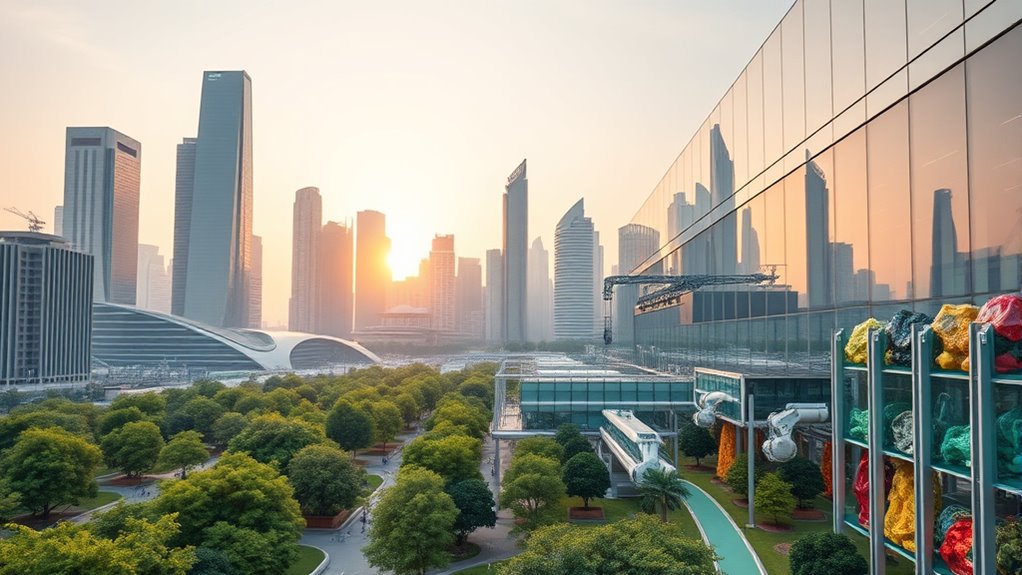
Integrating recycling and bioplastics into circular economy models is becoming increasingly feasible thanks to technological advances and supportive policies. You can expect bioplastics made from renewable or recycled materials to seamlessly fit into existing recycling systems, boosting circularity.
Emerging chemical and biological recycling methods enable turning waste into higher-quality materials, further closing the loop. Cost-effective recycling technologies are making it easier to process diverse types of bioplastics efficiently. Investments in recycling infrastructure and the adoption of closed-loop systems make product recyclability more achievable.
Collaboration among manufacturers, recyclers, policymakers, and consumers is crucial to scale these solutions. Additionally, integrating biopolymer recycling within broader sustainability frameworks reduces reliance on fossil fuels, cuts greenhouse emissions, and promotes sustainable agriculture.
As innovations continue, the combined efforts will drive a more resilient, eco-friendly plastics industry aligned with long-term environmental goals.
Frequently Asked Questions
How Will Advancements in Recycling Tech Impact Plastic Waste Reduction?
Advancements in recycling tech will profoundly reduce plastic waste by making recycling more efficient and effective. You’ll see improved sorting accuracy with AI, enabling better separation of plastics, even contaminated ones.
Chemical recycling methods like pyrolysis and depolymerization turn waste into valuable products, decreasing landfill reliance. These innovations allow you to recycle more types of plastics faster, supporting a circular economy and helping to cut down global plastic pollution.
What Role Do Emerging Markets Play in Global Recycling Growth?
You should recognize that emerging markets play a crucial role in global recycling growth. Their rapid urbanization and industrialization increase plastic waste, prompting governments to invest in recycling infrastructure.
How Are Hybrid Bioplastics Influencing Sustainability Strategies?
Imagine building a bridge from old to new—hybrid bioplastics act as that bridge in sustainability strategies. You see, they cut greenhouse gases by up to 80%, need 65% less energy to produce, and are biodegradable, closing the carbon cycle.
What Are the Main Barriers to Recycling Contaminated Plastics Effectively?
You face several barriers when recycling contaminated plastics effectively. Mixed materials and food residues cause contamination, making sorting difficult. Incompatible plastics and other materials like metal or adhesives further complicate processing.
Limited advanced separation technologies and high operational costs hinder quality recycling. Additionally, inadequate infrastructure, inconsistent regulations, and lack of public awareness reduce recycling efficiency.
Overcoming these challenges requires better sorting methods, supportive policies, and increased education to improve contamination management.
How Does Consumer Behavior Affect Future Recycling Industry Developments?
Your behavior shapes the future of recycling by influencing industry trends and innovations. When you recycle properly, support sustainable products, and advocate for better infrastructure, you encourage companies to develop eco-friendly materials like bioplastics.
Your awareness and participation can lead to improved recycling technologies and policies. By making conscious choices, you help create a more efficient, accessible, and environmentally responsible recycling industry that aligns with your values and drives positive change.
Conclusion
You’re on the front lines of shaping a sustainable future. Embracing new recycling tech, supporting policies, and fostering innovation can turn challenges into opportunities. Remember, Rome wasn’t built in a day—progress takes time and teamwork. By staying informed and active, you can help bridge the gap between today’s plastics and tomorrow’s greener solutions. Keep pushing forward; the ball’s in your court to make a lasting impact.
